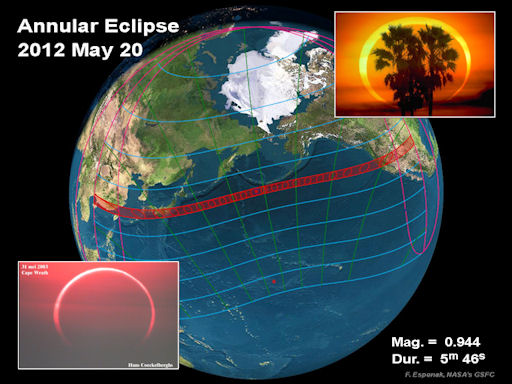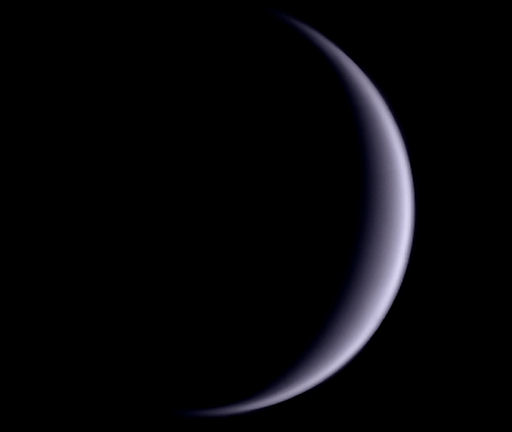They came from outer space--and you can have one! Genuine meteorites are now on sale in the Space Weather Store. | | | INTERPLANETARY SHOCK WAVE: An interpanetary shock wave possibly associated with the M5-class solar flare of May 17th swept past Earth on May 20th around 0200 UT. The shock's arrival caused geomagnetic activity around the poles, and several outbreaks of high-latitude auroras. Images: #1, #2. SOLAR ECLIPSE--TODAY!! On Sunday, May 20th, the Moon will pass in front of the Sun, producing an annular solar eclipse visible across the Pacific side of Earth. The path of annularity, where the sun will appear to be a "ring of fire," stretches from China and Japan to the middle of North America: 
Image credits (left to right): Hans Coeckelberghs, Fred Espenak, Dennis Mammana
An animated eclipse map prepared by Larry Koehn of ShadowandSubstance.com shows the best times to look. In the United States, the eclipse begins at 5:30 pm PDT and lasts for two hours. Around 6:30 pm PDT, the afternoon sun will become a luminous ring in places such as Medford, Oregon; Chico, California; Reno, Nevada; St. George, Utah; Albuquerque, New Mexico, and Lubbock, Texas. Outside the narrow center line, the eclipse will be partial. Observers almost everywhere west of the Mississippi will see a crescent-shaped sun as the Moon passes by off-center. Because this is not a total eclipse, some portion of the sun will always be exposed. To prevent eye damage, use eclipse glasses, a safely-filtered telescope, or a solar projector to observe the eclipse. You can make a handy solar projector by criss-crossing your fingers waffle-style. Rays of light beaming through the gaps will have the same shape as the eclipsed sun. Or look on the ground beneath leafy trees for crescent-shaped sunbeams and rings of light. Solar eclipse resources: VENUS TRANSFORMED: Something special is happening to Venus in the evening sky. The second planet is diving toward the sun for a much-anticipated transit on June 5-6. As Venus turns its night side toward Earth, the planet is transforming into a beautifully slender and colorful crescent: 
John Chumack of Dayton, Ohio, took the picture on May 14th using a 10-inch telescope. "I was blown away by the sight of Venus," he says. "The planet was 14% illuminated, 47 arcseconds in diameter, and blazing at -4.43 magnitude." The crescent shape of Venus is easy to see in good binoculars or small telescopes. No special observing experience is required. Just find Venus in the western sky after sunset (you can't miss it), point and look. A good tripod to hold the optics steady is recommended. As the evening wears on and Venus sinks toward the horizon, the refractive effect of Earth's atmosphere splits the crescent into the colors of the rainbow. Kevin R. Witman of Cochranville, Pennsylvania, observed the phenomenon on May 11th: "Earth's atmospheric refraction of Venus's ample light made a beautiful image through my 10-inch telescope." more images: from Mark Marquette of Boones Creek, Tennessee; from Philippe Vanden Doorn of Rixensart, Belgium; from Luis Argerich of Buenos Aires, Argentina; from Tomasz Gołombek of Tczew, Poland; from Francesc Pruneda of Palamós, Catalonia (Spain); from Sadegh Ghomizadeh of Tehran, Iran; Potentially Hazardous Asteroids ( PHAs) are space rocks larger than approximately 100m that can come closer to Earth than 0.05 AU. None of the known PHAs is on a collision course with our planet, although astronomers are finding new ones all the time. On May 20, 2012 there were 1293 potentially hazardous asteroids. Notes: LD means "Lunar Distance." 1 LD = 384,401 km, the distance between Earth and the Moon. 1 LD also equals 0.00256 AU. MAG is the visual magnitude of the asteroid on the date of closest approach. | | The official U.S. government space weather bureau | | | The first place to look for information about sundogs, pillars, rainbows and related phenomena. | | | Researchers call it a "Hubble for the sun." SDO is the most advanced solar observatory ever. | | | 3D views of the sun from NASA's Solar and Terrestrial Relations Observatory | | | Realtime and archival images of the Sun from SOHO. | | | from the NOAA Space Environment Center | | | the underlying science of space weather | | 
